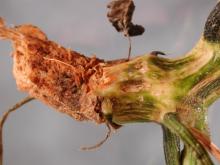See:
Squash (Cucurbita spp.) - Storage Rots
By Cynthia M. Ocamb and Hannah Rivedal
Cause Fusarium solani f. sp. cucurbitae (teleomorph: Nectria haematococca) is a problem in summer squash and some pumpkin varieties, especially Cucurbita maxima-type squash, though most cucurbits are susceptible under laboratory tests. The fungus can survive 2 to 3 years as chlamydospores in soil or plant debris, or longer by growing on the roots of other plants. It also can spread by infected seed (internally or externally infected) but reportedly survives on seed no longer than 2 years. Pre- and post-harvest rot of the fruit can occur, especially where there has been soil contact. There is specialization within this fungus and two races have been reported. This disease is exacerbated by the presence of a complex of soilborne pathogens: Fusarium culmorum, Fusarium oxysporum, Plectosphaerella cucumerina, and Setophoma terrestris.
Symptoms Plants at any stage of growth can be infected. Infection of an older plant is usually noticed once wilting occurs, and death of the affected plant may soon follow, leading to unripe fruit or sunburn, and yield loss. Affected plants have a characteristic rot of the crown and upper tap root area. A soft mushy rot of the stem, which turns dark brown at the base, may be visible when soil is removed. Early infections appear as a root rot with light-color, water-soaked areas that turn darker. The root cortex sloughs off, but the fibrous vascular tissue remains. Under wet soil conditions, the primary root may be infected but usually infection is through the crown, secondary roots, or the stem immediately above the soil line. A white to pink fungal growth may be visible at the soil line. Fruit can be infected if in contact with the soil under wetter conditions.
Cultural control
- Rotate out of squash and other cucurbits for 4 years.
- Avoid fields with a history of severe Fusarium disease.
- Use laboratory-tested pathogen-free seed.
- Select fields with good water drainage and avoid over-irrigation.
- Deficit irrigation (i.e., reducing water by no more than 40%) early in the season is associated with less disease incidence. Water should not be limited when fruit is setting.
- Avoid the injury of fruit during harvest, packing, and transport.
Chemical control Preharvest fungicide applications to plants have been reported to be ineffective because of inability to get sufficient fruit coverage (where the fruit are in contact with soil)
- Seed treatment may reduce disease caused by seedborne propagules.
- Treat seed with Maxim 4FS (Group 12) at 0.08 to 0.16 fl oz/100 lb seed plus a dye. Controls pathogenic Fusarium and Rhizoctonia spp. Treating weak or damaged seed may reduce germination and/or seed and seedling vigor.
Biological control
- Actinovate AG at 3 to 12 oz/A as a soil drench at planting. 4-hr reentry. O
- Actinovate Lawn & Garden at 0.5 to 1 teaspoon/gal water. H O
- Bexfond at 7 to 28 fl oz/A. 4-hr reentry. O
- Double Nickel LC at 1 to 2 quarts/A as a banded soil spray or drench on 4- to 6-week intervals or at 0.5 to 4.5 pints/A on 2- to 4-week intervals. 4-hr reentry. O
- Rootshield WP at 3 to 8 oz/100 gal water for greenhouse soil drench and field chemigation or at 16 to 32 oz/A as an in-furrow spray. 4-hr reentry. O
- Stargus at 3 to 4 quarts/A as a soil drench on 10- to 21-day intervals. Preharvest interval is 0 days. 4-hr reentry. O
Reference Rivedal, H.M., Stone, A.G., Severns, P.M., and Johnson, K.B. 2020. Characterization of the fungal community associated with root, crown, and vascular symptoms in an undiagnosed yield decline of winter squash. Phytobiomes. 4:178-192.


